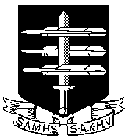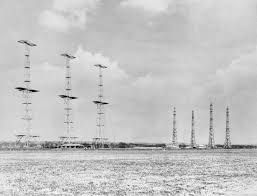

 The South African
The South African
by Gil Jacobs
Main Lecture address to the Johannesburg Branch on 12 September 2019
The electromagnetic spectrum extends from radiation with very long waves to radiation with very short waves. From the longest waves to the shortest we have radio, microwave, infra-red, visible light, x-rays, ultra-violet and gamma rays.
Visible light forms but a very small part of the electromagnetic spectrum. We see because our eyes are sensitive to visible light. We cannot sense radio waves or microwaves at all. (High intensity microwave radiation can harm us, as can x-rays, ultra-violet rays and gamma rays.)
James Clerk Maxwell showed mathematically that electromagnetic radiation exists.
In 1886 Heinrich Hertz showed experimentally that, just like light waves, radio waves can be reflected and refracted (bent) and can also interfere with each other. His experiments showed that Maxwell's theories are correct.
"I do not think that the radio waves I have discovered will have any practical application." - Heinrich Hertz
In 1932 Stanley Baldwin chillingly pronounced:-
"I think it is well for the man in the street to realise there is no power on Earth that can protect him from bombing, whatever people may tell him. The bomber will always get through. The only defence is in offence, which means that you have to kill more women and children more quickly than the enemy if you want to save yourselves."
Winston Churchill said:-
"The flying peril is not a peril from which one can fly."
Sir Robert Watson-Watt, who was generally considered to be "The Father of Radar" , was a descendant of James Watt, the inventor of the steam engine. He saw the potential of radar before the outbreak of World War II. He was known for his determination and perseverance, especially when things were going badly.
When Arnold "Skip" Wilkins and Robert Watson-Watt were asked to investigate rumours of a German "death ray" based on radio, Wilkins said that this was an impossibility. He then suggested that radio waves might be used to detect enemy aircraft.
On the 26th February 1935 Watson-Watt and Wilkins demonstrated that they could detect aeroplanes with radio waves which were reflected from them.
The development of radar had widespread support, but was opposed by some. Frederick Lindemann (Later Lord Cherwell) was Churchill's scientific advisor. He was against the idea of radar, he wanted to have cables suspended from balloons to bring down enemy aircraft. According to Dr E.G. Bowen he "lost no opportunity of throwing spanners into the radar works".
Bawdsey Manor became the headquarters for research on radar, but was evacuated when war broke out.
The British researchers built what became known as the Chain Home system. This was a chain of radar masts along the south and east coast of Britain which could estimate the distance, azimuth and height of incoming aircraft fairly accurately.

Chain home: transmission and receptor masts
Photo: Wikipedia
Air Marshall Sir Hugh Dowding has been credited with the victory in the battle of Britain. He was a strong proponent of radar.
Radar made it possible to know where and when the Luftwaffe were coming. It was thus possible for the British to deploy their fighters in the right place and at the right time. Without radar they would have had to spread their limited number of aircraft along the entire coastline.
Dowding came into conflict with Churchill - he did not want British fighter aircraft sent to France as they were too badly needed for the defence of Britain.
A German victory in the battle of Britain would almost certainly have made an invasion of Britain possible, with devastating consequences.
Radar became more accurate as the war progressed. The Chain Home system used wavelengths of about 12 metres, but it became possible to make radar with a wavelength of 10 centimetres. As frequency and wavelength are inversely related, this meant that generation of very high frequencies was needed. The power of the signals also had to be very high. The device which made this possible was the cavity magnetron which was first used to generate radar frequencies at the University of Birmingham on the 21st February 1940.
In 1940 the British decided to share their secret knowledge with the Americans because they had the resources to develop it further. One of these secrets was the cavity magnetron which was taken to America under great security. The result was that great strides were made in improving radar. This happened at the Radiation Laboratory at the Massachusetts Institute of Technology.
It became possible to build radar into aircraft. The aircraft so equipped included the Bristol, Beaufighter and Mosquito bombers.
The Nazi U-Boats were sinking a very large number of Allied ships each month. The outcome of the Battle of the Atlantic was crucial to the outcome of the war.
U-Boats were most vulnerable on the surface of the sea. They needed to surface to travel at speed as they only managed to do 5 knots under water. They also needed to surface to run the diesel engines which charged the batteries which powered them.
The underwater submarine detection system, known as ASDIC, was not good at detecting submarines on the surface.
Airborne radars could detect U-Boats at distances of more than 30 miles.The Germans started using the schnorkel to enable batteries to be charged while a U-Boat was submerged. It did not take long for radar to become sophisticated enough for the schnorkel to be detected!
The number of ships sunk by U-Boats fell dramatically and victory in the battle of the Atlantic was assured.
The two main reasons for this victory were the use of radar and the ability of the codebreakers at Bletchley Park to decrypt the Enigma code the Germans used to encrypt their directions to the U-Boats.
Nazi leaders on radar:-
"It was one single weapon... which defeated the German Submarine Service."
- Adolf Hitler
"The enemy has deprived the U-Boat of its essential feature - namely the element of surprise - by means of radar. With these methods... he has conquered the U-Boat menace. The scientists who have created radar have been called the saviours of their country." - Admiral Karl Dönitz
The uses of radar in peacetime are too many to mention. Among these uses are:-
A final thought:-
" 'The bomb may have ended the war but radar won it.'
This was the comment of many radar workers in August 1945 when the news of the atomic bomb upstaged the release of public knowledge of the MIT Radiation Laboratory, planned as a cover story for Time."
Louis Brown - A Radar History of World War II Technical and Military Imperatives
Return to Society's Home page
South African Military History Society / scribe@samilitaryhistory.org